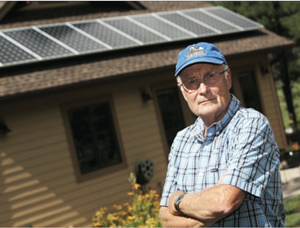By Christopher Leone | Arizona Daily Sun
Geoff Barnard recently put 10 solar panels on his roof, although he concedes that he and his wife were already big advocates of renewable energy and reducing their carbon footprint as much as possible.
“We don’t have a single incandescent bulb in the house,” Barnard said. “They’re all CFLs [compact fluorescent lamps], so we don’t use a lot of energy.”
Before installing the solar system, Barnard’s electric bill was about $60 per month. After installing a 2.6-kilowatt sys- tem, his bill dropped to about $10 to $20 per month.

GEOFF BARNARD STANDS in front of the roof-mounted solar array at his Flagstaff home Tuesday afternoon. / Jake Bacon/Arizona Daily Sun
One reason for the low bill is that Barnard is now using less electricity from Arizona Public Service and more from his rooftop panels. (The average solar monthly bill, says APS, is $62 a month). Another is that when the sun is shining and he’s not using much electricity, the excess solar power is bought back by APS at the same price as the utility sells its power to him.
The billing arrangement, called net metering, helps solar customers like Barnard pay off their installation costs even faster because of the greater monthly savings.
But APS says net metering doesn’t recover the fixed costs of transmission lines and other infrastructure that solar customers still use. It is proposing to cut by more than half — from 12 cents a kwh to 5 cents — the price it buys back excess electricity from rooftop solar customers, a move that would more than double the average monthly electric bill for a solar customer. (APS is also proposing to in- crease incentives for installing a rooftop solar system.)
That cut in the buyback price, in turn, might make discourage many prospective rooftop installations, putting the nascent solar panel industry in Arizona into a
financial tailspin.
If APS’s request is denied, the utility would probably have to ask for an over- all rate increase to offset net metering’s pinch on its ability to recover its fixed costs from rooftop solar clients, said Barbara Lockwood, general manager for energy innovation at Arizona Public Service. That means nonsolar customers would be subsidizing solar even more.
Also: Record PV Demand From China And Japan Marks Turning Point For Solar







